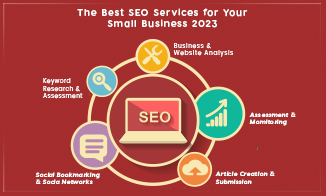Search engine optimization (SEO) is an essential aspect of online business that cannot be ignored. SEO helps businesses improve their online visibility, drive organic traffic, and increase sales. In today’s digital age, having a website with proper SEO optimization is crucial as it can directly impact a business’s success.
Key Takeaways:
- SEO is necessary for online businesses to succeed.
- SEO helps improve online visibility.
- SEO can drive organic traffic and increase sales.
Understanding SEO and Its Benefit
Search engine optimization, is the practice of optimizing a website to increase its visibility and ranking on search engine results pages (SERPs). Essentially, it involves improving the quality and relevance of a web page so that it appears higher in search engine rankings, thereby driving more traffic to the site.
There are a variety of benefits to SEO, including:
- Increased visibility: By ranking higher on SERPs, a website is more likely to be seen by potential customers.
- Organic traffic: It can lead to an increase in organic traffic, or traffic that comes to a website naturally through search engine results as opposed to paid advertising.
Improved website rankings: Higher rankings on SERPs can lead to increased credibility and authority in the eyes of potential customers.
The benefits of SEO are numerous, making it an essential component of any successful online business strategy. By investing in search engine optimization, businesses can improve their online presence and attract more customers.
Enhancing Website Visibility with SEO:
Improving website visibility is essential to the success of any online business. In order to achieve this, there are several SEO strategies that can be employed:
| SEO Strategy | Description |
| Keyword Research | Conducting research to determine the most relevant and valuable keywords to target in website content. |
| On-page Optimization | Optimizing website content, meta tags, and other on-page elements to align with identified keywords and improve search engine visibility. |
| Link Building | Building a network of high-quality backlinks to a website, which signals to search engines that it is a valuable and trustworthy source of information. |
By implementing these SEO strategies, businesses can significantly improve their website visibility and attract more organic traffic to their site.
Keyword Research
Keyword research is one of the most critical components of any search engine optimization strategy. This involves researching and identifying the most relevant and valuable keywords for a business (based on factors such as search volume and competition), as well as analyzing the keywords used by competitors and determining opportunities for keyword differentiation.
Once the most relevant keywords have been identified, they must be strategically incorporated into website content, meta tags, and other on-page elements to improve search engine visibility. However, it is important to avoid “keyword stuffing,” or overusing and repeating keywords in a way that appears unnatural or Spammy to search engines.
On-page Optimization
On-page optimization involves optimizing various elements of a website to align with identified keywords and improve search engine visibility. This includes optimizing website content (including page titles and descriptions), ensuring proper use of header tags (such as H1, H2, and H3), and using structured data markup to provide additional context to search engines.
It is also essential to ensure website content is high-quality, relevant, and engaging for site visitors. By providing valuable information and resources to visitors, businesses can keep visitors on the site longer and signal to search engines that the site is a valuable source of information.
Link Building
Link building involves building a network of high-quality backlinks to a website, which signals to search engines that it is a valuable and trustworthy source of information. This can be achieved through various tactics, such as guest blogging, creating valuable content, and participating in relevant industry forums and communities.
It is important to ensure that backlinks come from reputable and relevant sources, as search engines can penalize sites with low-quality or spammy backlinks. Building a network of high-quality, relevant backlinks takes time and effort, but can have a significant impact on improving search engine visibility.
Overall, enhancing website visibility through SEO strategies is essential to the success of online businesses. By conducting keyword research, optimizing on-page elements, and building a network of high-quality backlinks, businesses can significantly improve search engine visibility and attract more organic traffic to their site.
Improving Customer Engagement through SEO
Customer engagement is crucial for the success of any online business. SEO tactics can play a significant role in improving customer engagement and satisfaction. By employing the following strategies, businesses can enhance their customer experience and boost their online reputation:
- Optimizing website content: Customers are attracted to high-quality, informative content that is relevant to their needs. By optimizing website content with best SEO techniques such as incorporating keywords and meta descriptions, businesses can improve visibility on search engine results pages (SERPs) and engage customers with valuable information.
- Implementing user-friendly designs: Cluttered or confusing website designs can frustrate customers, leading to less time spent on the site and a higher bounce rate. By optimizing website designs with user experience in mind, businesses can create a more enjoyable and efficient browsing experience for customers.
- Leveraging social media integration: Social media can be a powerful tool in engaging customers and promoting online businesses. By integrating social media platforms with best SEO strategies such as optimizing posts with keywords and incorporating links, businesses can increase engagement and drive organic traffic to their website.
By implementing these tactics, businesses can improve customer engagement and build a loyal customer base. Happy customers are more likely to return to a website and recommend it to others, leading to increased traffic and higher conversion rates.
Increasing Website Traffic with SEO
One of the primary goals is to drive organic traffic to a website. By improving the visibility of a website in search engine results pages (SERPs), businesses can increase the likelihood of attracting relevant visitors, which can ultimately translate into sales or conversions. Here are some Top SEO techniques that can help boost website traffic:
Content Marketing
Creating high-quality, informative, and engaging content that resonates with your audience is crucial for attracting and retaining visitors. By optimizing your content for search engines, you can ensure that it ranks well for relevant keywords and phrases, driving organic traffic to your website. Some best practices to keep in mind include conducting keyword research, writing compelling headlines and meta descriptions, incorporating multimedia elements, and adhering to on-page SEO guidelines.
Local SEO
If you have a local business, optimizing your website for local search can help you attract nearby customers who are looking for products or services similar to yours. This involves creating local business listings on search engines and directories, optimizing your Google My Business profile, building local citations, and managing online reviews. By using local SEO techniques, you can increase your visibility in local search results, attract the right customers, and boost your website traffic.
Mobile Optimization
With more people accessing the internet through mobile devices, it’s essential to ensure that your website is optimized for mobile users. This involves implementing a mobile-friendly design that adjusts to different screen sizes, improving page load speed, simplifying navigation, and minimizing distractions. By providing a positive mobile user experience, you can attract and retain more visitors, leading to increased website traffic and engagement.
Conclusion
Incorporating these SEO techniques into your digital marketing strategy can help you achieve higher website traffic, which can ultimately lead to increased sales and revenue for your online business. By creating high-quality content, optimizing for local search, and providing a seamless mobile user experience, you can attract and retain more visitors, convert them into customers, and stay ahead of the competition.
Boosting Website Rankings Through SEO
If you want your website to appear at the top of search engine results pages (SERPs), you need to invest in effective SEO strategies. There are several techniques you can use to improve your website’s ranking, including:
Choosing the right keywords: Conduct keyword research to find out what your target audience is searching for and optimize your website content with those keywords.
- On-page optimization: Optimize your website’s meta tags, headings, and content to make it more relevant to search engines and users.
- Link building: Build high-quality backlinks to your website from other authoritative websites to improve your website’s authority and boost its ranking.
- Structured data: Use structured data to help search engines better understand your website’s content and improve its visibility in search results.
- Page speed optimization: Improve your website’s page speed to provide users with a better experience and boost your website’s ranking.
However, it’s important to note that SEO is an ongoing process that requires constant attention and adaptation. Search engines are constantly updating their algorithms, and your competitors are always looking for ways to improve their own rankings. To stay ahead of the game, you need to keep up with the latest SEO trends and best practices.
SEO and the User Experience
The user experience plays a critical role in website optimization. A positive user experience can lead to higher engagement, which in turn can boost website rankings on search engine results pages (SERPs). To optimize your website for both users and search engines, it’s essential to integrate SEO tactics into your user experience design.
Website navigation is one of the most crucial aspects of user experience optimization. A well-organized website structure can help visitors find the information they need quickly and efficiently. This can lead to higher engagement, lower bounce rates, and increased time spent on the site, all of which can improve search engine rankings.
Mobile-friendliness is another critical factor to consider when optimizing user experience. As mobile devices continue to dominate the Internet, websites that are not optimized for mobile users risk losing out on traffic and potential customers. Optimizing your website for mobile users, such as creating responsive designs and using mobile-friendly formats, can help improve user engagement and search engine rankings.
Implementing user-friendly site structure and mobile optimization can improve the user experience and lead to higher engagement, which can boost search engine rankings. Integrating into the user experience design process can help businesses achieve both.
Harnessing the Power of Local SEO
For businesses targeting specific geographic regions, local SEO optimization is a must. By ensuring your website appears at the top of search engine results for location-based queries, you can attract more relevant local traffic and improve your visibility to potential customers within your target area.
Implementing effective local SEO strategies requires a multi-faceted approach. One crucial element is optimizing your Google My Business listing, the information displayed on Google Maps and search results. Ensuring your listing is complete, accurate, and up-to-date can go a long way in boosting your local search visibility.
Another key component is building local citations, or mentions of your business on other websites, particularly directories and review sites. These citations can improve your credibility and authority with search engines.
Online reviews also play a crucial role in local SEO. Positive reviews can boost your local search rankings, while negative reviews can harm your rankings and reputation. Encouraging satisfied customers to leave positive reviews can be an effective way to improve your local search visibility and attract more customers.
- Optimize your Google My Business listing
- Build local citations
- Encourage positive online reviews
By fully harnessing the power of local SEO, businesses can improve their online presence and attract more relevant local traffic, ultimately leading to increased conversions and revenue.
SEO and Content Marketing Synergy
Content marketing and SEO are two sides of the same coin, and both work together to achieve the same goal: driving traffic to your website. SEO integration with content marketing is a powerful strategy to improve brand awareness, target audience engagement, and reach a wider audience.
By integrating SEO with content marketing, businesses can create high-quality and engaging content that is optimized for search engines, and thereby increase their visibility and ranking on search engine result pages. Content marketing enables businesses to connect with their audience by creating content that is informative, entertaining, and shareable. Integration ensures that the content is optimized for search engines and ranks higher in search results.
One of the key SEO integration strategies with content marketing is keyword research. By identifying the relevant keywords for your industry, you can create keyword-rich content that connects with your target audience. Keyword research helps identify the phrases and terms that people use to search for products or services similar to yours. By integrating these keywords into your content, you can boost your website’s visibility and attract more organic traffic.
The Benefits of SEO and Content Marketing Integration
| Benefits of SEO and Content Marketing Integration | Explanation |
| Increased visibility | By integrating SEO into your content marketing strategy, you can increase your website’s visibility in search results. |
| Higher website ranking | SEO-integrated content ranks higher in search results, increasing the chances of getting clicked by users. |
| Increase in organic traffic | Create content that is optimized for search engines, and attract organic traffic to your website. |
| Enhanced user experience | SEO-integrated content improves the user experience by delivering informative and relevant content that the user’s search query intent. |
SEO-integrated content is also shareable, which helps increase its reach and overall engagement. When people share your content on social media platforms, it improves your reach and authority, which, in turn, boosts your search engine ranking.
SEO and Content Marketing integration is an ongoing process. By analyzing your website’s performance, tracking metrics, and continuously updating and optimizing your content, you can improve your website’s visibility, user engagement, and ranking on search engine result pages.
Measuring SEO Success and ROI
Measuring the success of your SEO efforts is crucial to determine the return on investment (ROI) and identify areas for improvement. There are several metrics and tools available to help you track your progress and calculate the ROI of your SEO strategies.
Organic Traffic
Organic traffic refers to the number of visitors that come to your website via search engines like Google or Bing. By monitoring the organic traffic to your site, you can analyze the effectiveness of your SEO strategies in generating visibility and attracting potential customers. Tools like Google Analytics can provide insights into organic traffic trends, sources of traffic, and user behavior, helping you fine-tune your SEO tactics.
Keyword Rankings
Keyword rankings refer to the position of your website on search engine results pages (SERPs) for specific keywords or phrases. By tracking your keyword rankings, you can assess the effectiveness of your SEO efforts in targeting relevant search terms and driving traffic to your site. Tools like SEMrush or Ahrefs can help you monitor your keyword rankings and identify opportunities to optimize your content and site structure.
Conversion Rates
Conversion rates refer to the percentage of visitors to your site who take a desired action, such as making a purchase, filling out a contact form, or subscribing to a newsletter. By tracking your conversion rates, you can evaluate the impact of your SEO strategies on customer engagement and sales. Tools like Google Analytics or Web Masters can help you measure and analyze your conversion rates, and identify areas for improvement.
ROI Calculation
To calculate the ROI of your SEO strategies, it’s important to consider your investment in terms of time and resources, as well as the revenue generated by increased website traffic and conversions. By assessing the cost and benefit of your SEO tactics, you can determine the return on investment and evaluate the effectiveness of your overall marketing strategy. Tools like HubSpot’s ROI calculator can help you calculate the ROI of your SEO efforts and make data-driven decisions for future campaigns.
Overall, by measuring the success of your SEO strategies and calculating the ROI, you can optimize your online presence and drive sustained growth for your business.
Staying ahead with SEO best practices
As the online landscape continues to evolve, it’s important for businesses to stay up-to-date with the latest SEO best practices. By continuously improving and adapting your SEO strategies, you can maintain a competitive edge and continue to drive organic traffic and engagement to your website.
Stay informed on algorithm updates
Search engine algorithms are constantly evolving, and it’s crucial to stay informed on any updates that may affect your website’s ranking. Follow industry blogs and experts and monitor your website’s performance to identify any potential drops in traffic or rankings.
Focus on user experience
User experience is a key component of SEO, as search engines prioritize websites that provide a positive experience for users. Ensure your website is mobile-friendly, has a clear structure and navigation, and provides relevant, high-quality content that aligns with your SEO strategies.
Invest in quality content
Content marketing and SEO are intertwined, and creating high-quality, relevant content is essential for driving organic traffic and engagement. Focus on creating content that provides value to your target audience and incorporates relevant keywords and topics.
Regularly audit your website
Regular website audits can help identify any technical issues that may affect your SEO performance, such as broken links, slow page speed, or errors in meta tags. Use tools like Google Analytics and Search Console to monitor your website’s performance and identify areas for improvement.
Engage with your audience
Social media is a powerful tool for engaging with your audience and driving traffic to your website. Incorporate social media integration into your SEO strategies and regularly engage with your followers through posts, comments, and surveys to build brand loyalty and drive engagement.
By incorporating these SEO best practices into your online business strategies, you can stay ahead of the competition and continue to drive organic traffic and engagement to your website.
Conclusion
SEO is an essential aspect of online business that cannot be ignored. In this article, we have explored the various benefits that SEO can bring to a website, including increased visibility, improved customer engagement, higher traffic, and better search engine rankings.
We have discussed the strategies and techniques that can be employed to enhance website visibility, drive organic traffic, and boost search engine rankings, such as on-page optimization, link building, content marketing, and local SEO.
Furthermore, we have highlighted the importance of providing a positive user experience through website navigation, site structure, and mobile-friendliness, as well as the relationship between SEO and content marketing. Finally, we have emphasized the significance of measuring SEO success and staying ahead with the latest trends and best practices.
In conclusion, SEO is crucial for online businesses to achieve success in the digital landscape. By prioritizing SEO strategies and employing best practices, businesses can improve visibility, attract customers, and drive sales, regardless of their industry or niche.
FAQ
Q: Why is SEO important for online business?
A: SEO is important for online businesses because it helps improve visibility, customer engagement, and sales.
Q: What is SEO and what are its benefits?
A: SEO stands for Search Engine Optimization, and its benefits include increased visibility, organic traffic, and improved website rankings.
Q: How can SEO enhance website visibility?
A: SEO strategies such as keyword research, on-page optimization, and link building can be employed to improve website visibility.
Q: How does SEO improve customer engagement?
A: SEO can enhance customer engagement by optimizing website content, implementing user-friendly designs, and leveraging social media integration.
Q: How does SEO increase website traffic?
A: SEO can drive higher volumes of organic traffic to websites through techniques like content marketing, local SEO, and mobile optimization.
Q: How can SEO boost website rankings?
A: Improving website rankings on search engine results pages (SERPs) can be achieved through techniques such as meta tags, structured data, and page speed optimization.
Q: What is the correlation between SEO and user experience?
A: SEO and providing a positive user experience go hand in hand, with topics including website navigation, site structure, and mobile-friendliness.
Q: Why is local SEO important?
A: Local SEO is important for businesses targeting specific geographic regions, and strategies include optimizing Google My Business, local citations, and online reviews.
Q: How does SEO integrate with content marketing?
A: SEO and content marketing work together, emphasizing the importance of creating high-quality, relevant content that aligns with SEO strategies.
Q: How can I measure SEO success and ROI?
A: Key metrics and tools available to measure SEO success and calculate return on investment (ROI) include tracking organic traffic, keyword rankings, and conversion rates.
Q: How can I stay updated with SEO best practices?
A: Staying ahead with SEO best practices involves staying updated with the latest trends, algorithm updates, and industry best practices necessary to maintain a competitive edge.






